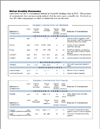Stormwater Management Plan
Click here to view the Town's Stormwater Management Plan. The plan was last updated in June 2023.
![]() Please visit the Unibank site to pay your water bill.
Please visit the Unibank site to pay your water bill.
Click here to view the Town's Stormwater Management Plan. The plan was last updated in June 2023.
The Select Board has set the FY2025 water rates. The FY2025 rate schedule is available online. The rates are based on the budget approved at Town Meeting in May 2024 and the water use forecast for FY2025.
 The 2023 Water Quality Report is available online. Copies will be mailed to customers and will also be available at the Water Department Office once they are printed. Please visit our water quality website http://watertesting.topsfieldpublicworks.org for more water testing results.
The 2023 Water Quality Report is available online. Copies will be mailed to customers and will also be available at the Water Department Office once they are printed. Please visit our water quality website http://watertesting.topsfieldpublicworks.org for more water testing results.
The United States Environmental Protection Agency (EPA) issued the final PFAS regulations on April 10, 2024. The regulations were initally issued in draft form during 2023.
EPA Regulations
The new EPA regulations set Maximum Contaminant Levels (MCLs) for PFOA (perfluorooctanoic acid) and PFOS (perfluorooctane sulfonic acid) at 4 parts per trillion (ppt); PFNA (perfluorononanoic acid), PFHxS (perfluorohexanesulfonic acid), and GenX (hexafluoroproplene oxide) at 10 ppt; and a hazard index for mixtures of PFNA, PFHxS, GenX and PFBS.
The new regulations are being phased into effect. Systems are required to start testing for these compounds within 3 years, report the results in the annual Water Quality Report, and notify customers of any violations. Systems have 5 years to comply with the new MCLs by either installing appropriate treatment or finding alternative PFAS-free water supplies.
The regulations also created Maximum Contaminant Level Goals (MCLGs) for PFOS and PFOA of 0 ppt. This means that EPA would like to eliminate PFOS and PFOA from water supplies accross the country but current testing protocols, treatment methods, and economic conditions make it infeasible. We expect the MCLs to drop as testing and treatment methods improve.
Our offices are staffed during normal business hours. If you need to contact us after hours for downed tree blocking a road, low water pressure, or to report a water main break call 911. The Town is part of the Essex County Regional Communications Center and using 911 is the only way to contact us after hours.
Subscribe to our email list to receive water quality notices, daily hydrant flushing updates and water restriction information.
We receive calls about higher than normal water bills on a regular basis. Under normal circumstances we’d schedule an appointment to visually check the meter, look for leaks, etc. However, we are not entering homes or businesses for the foreseeable future unless it’s for an emergency.
When confronted with a high bill, customers often ask questions such as where did the water go or how could I possibly use that much water. Well the simplest answer is that from the limited information available, there is really no possible way for us to know where the water went once it went through the meter. The information used to generate the bill – start and end meter readings can be augmented with one or two readings taken during the billing cycle and that is about it. A similar question would be where did I drive my car over the past 3 months based on start/end odometer readings. The result would be a similar answer - we don’t know where you went, just how far.
However, if monthly readings are available then the pattern and volume of use may make one explanation more reasonable than others but in the end it’s our best guess. In some cases, an explanation can’t be found and it comes down to meter accuracy – did the water go through the meter or not. Meters are typically pulled and sent to a vendor for testing when this occurs.
Once the readings are verified then we can start asking questions such as:

We conduct hundreds of water quality tests each year. Results are now available on our Water Quality Site which includes information about which water sources are in use. The site has been under development for several years and more functionality will be added as time permits.
279 Boston Street
Topsfield, MA 01983
978.887.1517
911 - After Hours Emergency
Office Hours: Monday-Friday 7 AM to 2:00 PM
279 Boston Street
Topsfield, MA 01983
978.887.1542
Hours: Monday-Friday 7 AM to 3 PM